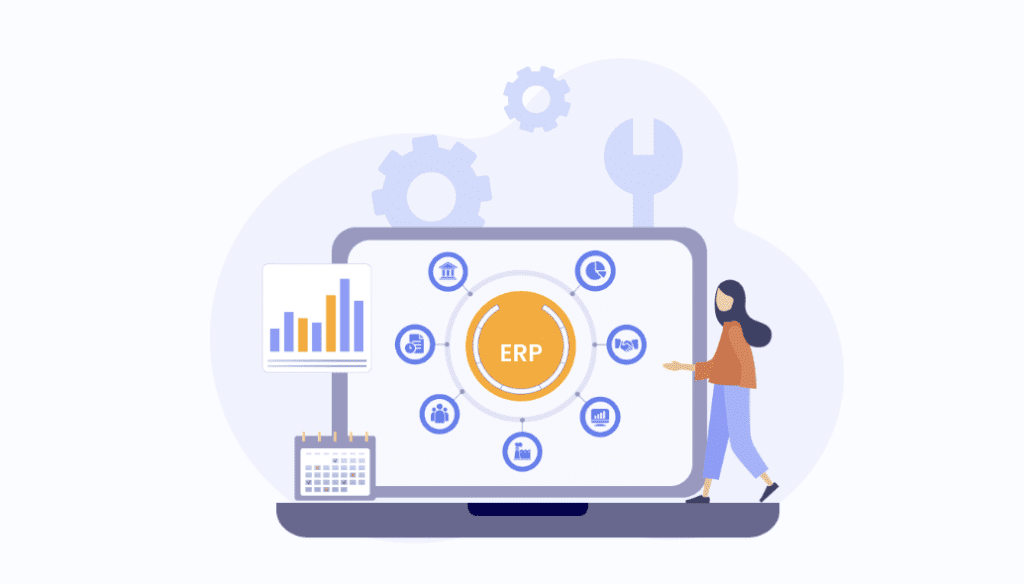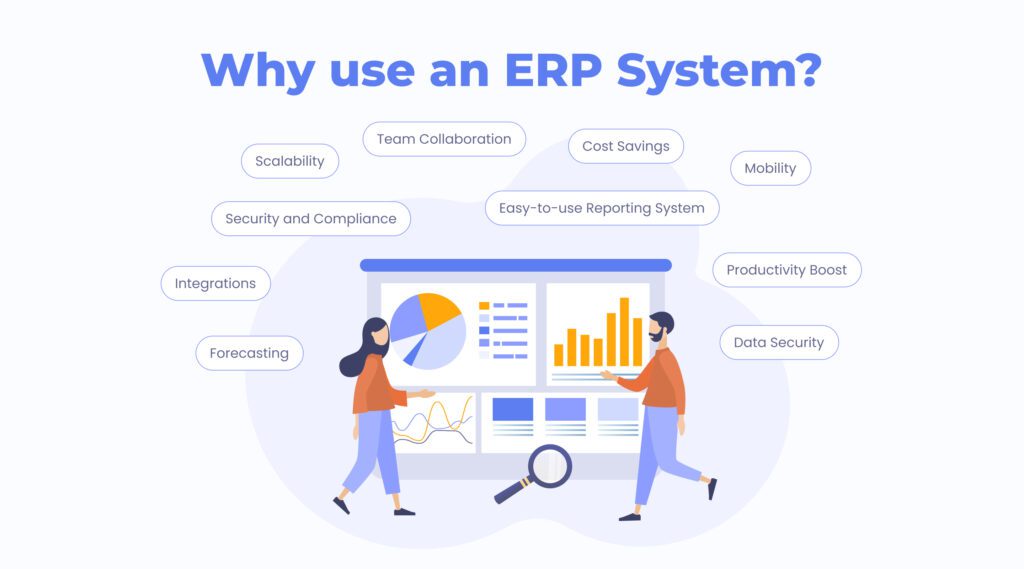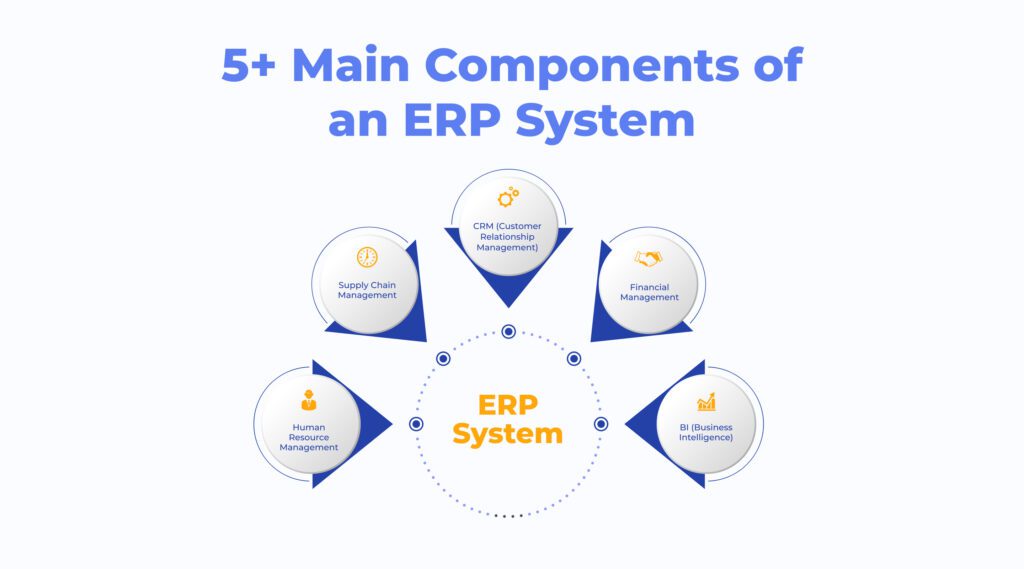TL;DR
- ERP centralizes finance, HR, inventory, orders, and CRM to streamline operations.
- Core components: Financials, BI, CRM, Supply Chain, HR; plus reporting and integrated database.
- Cloud-based ERP integrates data across departments for real-time visibility and better decisions.
- Benefits include scalability, security, integrations, faster forecasting, collaboration, and cost savings.
Fact Box
- Five main ERP components: Financials, BI, CRM, Supply Chain, and HR Management.
- ERP now commonly runs as cloud-based software with remote, web-based access.
- ERP integrates cross-department data to cut manual entry and provide real-time visibility for decisions.
- Integrations with CRM, HRIS, and eCommerce automate data flow and reduce errors and duplicates.
- ERP reporting lets users build custom reports without coding and save templates for reuse.
Wondering what is an ERP (Enterprise Resource Planning) system? What are the main components needed for it to be effective? What benefits can it provide to my business? These are the most common questions you may ask yourself while looking for an ERP system.
ERP systems can help make a business more efficient and productive. The importance of having an ERP system in place is growing, as more and more businesses are being forced to find ways to streamline their processes and remain competitive in a modern business climate. Studies have found that an ERP system can help reduce costs and increase productivity.
By reading this article, you will know the 5 main components of an ERP system, and how it can help your business become more efficient and productive.
What is an ERP System?

Enterprise Resource Planning (ERP) is a powerful tool businesses use to streamline various processes. The software aids in managing inventory, order management, finances, human resources, and Customer Relationship Management.
Why use an ERP System?

An ERP system strives to provide a comprehensive overview of an organization’s crucial data and processes, ultimately improving efficiency, visibility, and decision-making capabilities. With an ERP system, data and processes from different departments and systems are integrated, reducing the need for manual data entry and reconciliation while providing real-time access to data. The result is a more efficient and effective business operation.
Scalability
An ERP system is a must-have for businesses looking to expand. Scalable ERP solutions can provide the resources needed to support more users, data, and features. These solutions are adaptable to changing business needs and can easily be adjusted to include new users or features. With a scalable ERP system, businesses will have the necessary performance and availability even when faced with more data and users. Ultimately, the ERP system is an essential part of the growth process, providing essential data for making informed decisions. 
Security and Compliance
When choosing an ERP system, it’s crucial to ensure that it has effective security measures and compliance protocols in place. This is necessary to protect sensitive data, comply with regulations, minimize risks, maintain business continuity, and establish customer trust. The system should be capable of safeguarding data, meeting regulatory requirements, reducing risks, preserving business operations, and promoting customer confidence. With such robust security and compliance capabilities, organizations can be confident that their data is safe, regulations are being followed, risks are being minimized, business operations are uninterrupted, and customer trust is maintained.
Integrations
Integrations are an essential part of ERP software, facilitating smooth data transfers between various business systems such as CRM, HRIS, and eCommerce. By automating data flow and reducing the need for manual entry and reconciliation, integrations can help to reduce errors, duplicate data, and the time and effort required for data transfer. Additionally, by consolidating data sources and providing a single source of truth for data across the organization, integrations can improve visibility and decision-making while cutting costs.
Forecasting
The implementation of an ERP system is a game-changer for precise and speedy forecasting. With centralized database access, users can now streamline the entire process for maximum efficiency. Not only does this method of forecasting lead to more accurate predictions, but it also empowers users to make informed decisions about their business operations and plan for future scenarios with greater precision. By using ERP systems, the time and effort needed to generate forecasts are significantly reduced.
Team Collaboration
Having all the company’s data stored in one centralized database, and divided among various departments and areas, makes accessing and operating required data so much simpler. This, in turn, makes internal and external operations more efficient. Additionally, data centralization also facilitates staff collaboration, which is always a plus! This makes internal and external operations more efficient, and data centralization further facilitates staff collaboration.
Cost Savings
Implementing an ERP system is a complex and costly endeavor, yet it proves to be budget-friendly for the company. This is due to two reasons:
- Managers can easily regulate the system themselves without the need for IT staff involvement.
- With the increased efficiency of the system, there is a lower likelihood of errors, delays, and additional costs associated with fixing any problems.
Productivity Boost
By automating repetitive tasks, employees can dedicate their focus and energy to their core responsibilities, leading to an increase in productivity. Not only does automation save time, but it also reduces the likelihood of human error that can result from manual execution. Furthermore, automating certain processes ensures efficient utilization of resources, allowing organizations to scale their operations quickly and effectively. The automation of tasks can also enhance customer satisfaction by providing a streamlined and efficient experience.
Mobility
Users of certain ERP systems can enjoy uninterrupted access to the system from any location with an internet connection. This flexibility allows users to work remotely while still being able to access all the necessary information and tools required to complete their tasks. The ability to collaborate in real time from different locations also enhances teamwork and efficiency. Furthermore, the remote access feature allows for faster response times to customer queries, resulting in improved customer service and more efficient operations.
Data Security
Protecting confidential data is a top priority for any manager. With the use of ERP, you can have complete control over who can access certain information. This means you can limit access and safeguard your company’s data from unauthorized individuals.
Easy-to-use Reporting System
Generating reports has never been easier! With ERP systems, you can customize and create reports of any complexity without any coding or programming experience. You’ll also love the ability to save templates for future use, saving you time and hassle. And when it comes to sharing, you won’t need any IT professionals to help you distribute reports to those who need them.
How Does It Work?
ERP has come a long way from its original incarnation of physical client servers and manual entry systems. Today, cloud-based software with remote, web-based access is the norm, allowing businesses to rent services from the platform’s hosting company. The process begins with the selection of desired applications, which the hosting company then loads onto the client’s server. Next, integration of the client’s systems and data into the platform ensues, and once all departments are connected to the system, the data is stored on the server and accessible to all with permission. The platform can also generate metrics, graphs, and other visuals to aid the client in evaluating the performance of the business and its departments.
5+ Main Components of an ERP System

Financial Management
Financial management components of an ERP system offer companies a powerful tool to store, monitor, and analyze financial data. This data can include accounts payable, accounts receivable, costs, budgets, and forecasts, giving you valuable insights into spending habits, profit trends, and times of unusually high spending. By leveraging this information, companies can make changes to processes that boost profits and reduce costs, maximizing their budgets and increasing overall financial performance. When selecting a financial ERP solution, ensure it is suitable for your business size and goals, and that it allows for scalability as your company grows. Additionally, look for a system that can improve cash flow, lower costs, and provide accurate reporting and tax compliance. With the right financial ERP system in place, businesses can gain a competitive edge while streamlining operations and supporting economic growth.
Business Intelligence (BI)
In today’s competitive business environment, data-driven decision-making processes are a priority for many companies. To support this, ERP software now includes Business Intelligence (BI) as a key feature. The BI module collects and analyzes data to provide insight into business operations, acting as an early warning system for your organization. With this technology, you can easily monitor your key performance indicators (KPIs) and take action quickly to make necessary adjustments.
Customer Relationship Management (CRM)
When looking into an ERP system, it is essential to consider how it can help your sales and marketing teams enhance customer satisfaction. One approach is to incorporate a CRM component that records customer and sales data. With this data, you can make adjustments to your marketing and sales processes to maximize efficiency. Additionally, your ERP system should have features to manage invoices and proposals, monitor contract status, and monitor customer purchase histories. By tracking this data, you can suggest extra purchases through cross-selling or upselling, or present customers with relevant products/services that they may not have known about.
Supply Chain Management
In the manufacturing and distribution business, an effective ERP system is essential. It should provide the necessary features to monitor demand, supply, manufacturing status, logistics, and distribution in real-time. The SCM and SCP components of an ERP system are essential for enhancing the supply chain. Having access to real-time data is the key to making them function properly and identifying potential problems promptly. Additionally, sharing data with supply partners is important for avoiding any delays. The SCM feature of an ERP system allows you to stay on top of your supply chain by having access to real-time data and demand planning. This way, you can create a production plan that accurately meets current demand without exceeding it.
Human Resource (HR) Management
Effective employee management is an absolute necessity for any business to thrive. That’s why an ERP system equipped with an HR component is not just important, but essential! The HR component can expertly handle all aspects of employee management from beginning to end with ease. Payroll software is a standout feature of the HR component. Manually handling payroll and direct deposits is a tedious task that can eat up valuable time. With automated payments, including deductions for taxes and benefits, more time can be spent on other pressing responsibilities. Investing in an HR component for your ERP system is a smart move that can dramatically streamline your business operations.
Summing Up
An Enterprise Resource Planning system is a comprehensive solution that integrates various business applications to facilitate the management of an organization’s financials, supply chain, human resources, and customer relations. It comprises several key components, including an integrated database, user interface, application modules, reporting, and underlying architecture. By leveraging these components, an ERP system allows businesses to optimize their operations, enhance customer service, and improve overall efficiency.
The components of an ERP system are based on the building blocks of bricks. Depending on the size and needs of a company, the quantity of these components may vary. It’s entirely up to you whether you opt for a ready-to-use ERP system with pre-built components or create one according to your specific preferences. If you opt for the second one, Flatlogic can provide you with a solution that meets your needs with confidence.